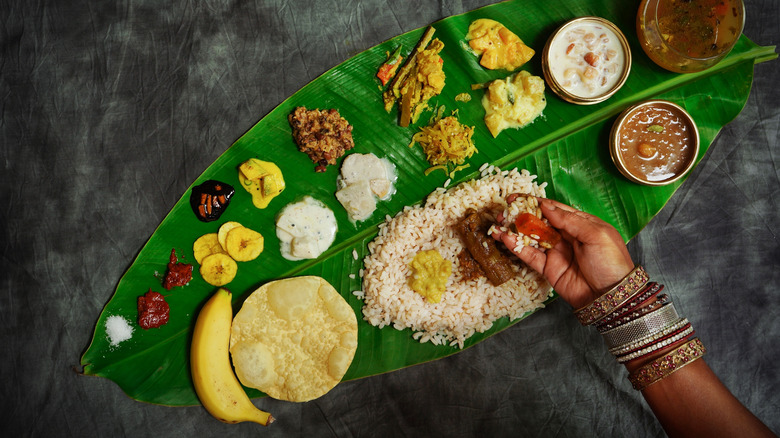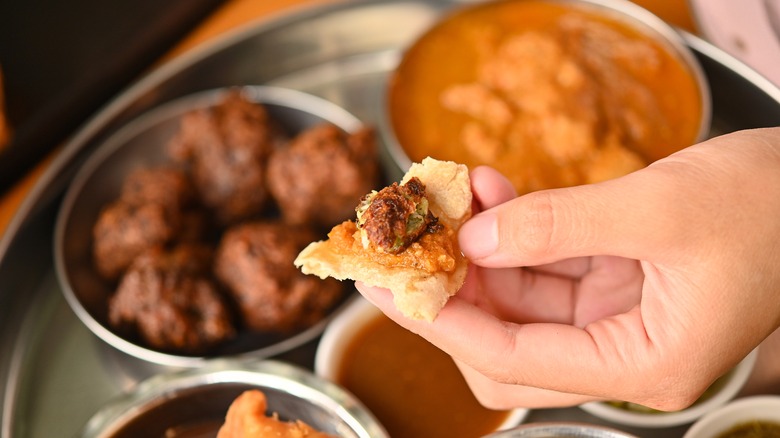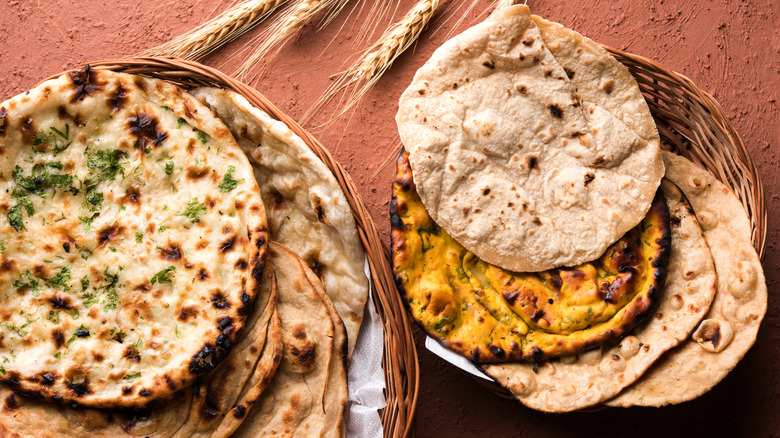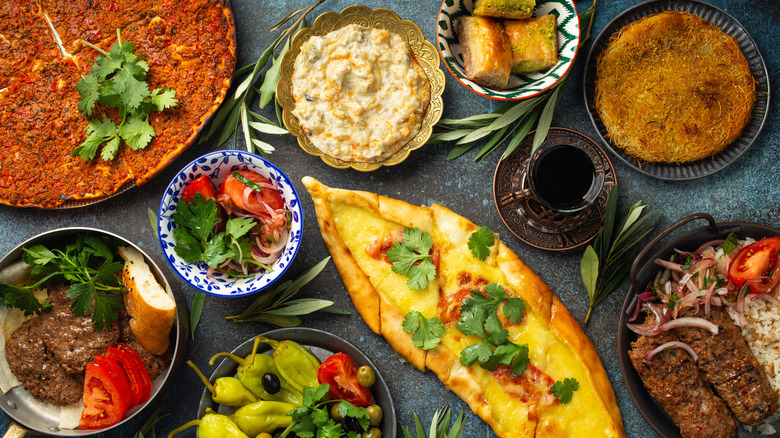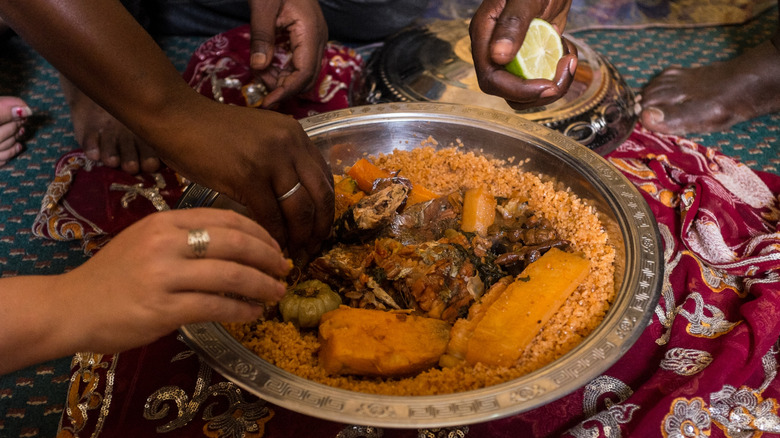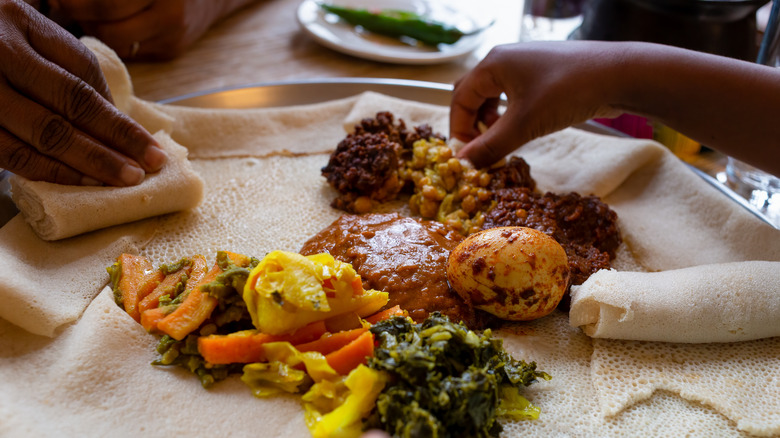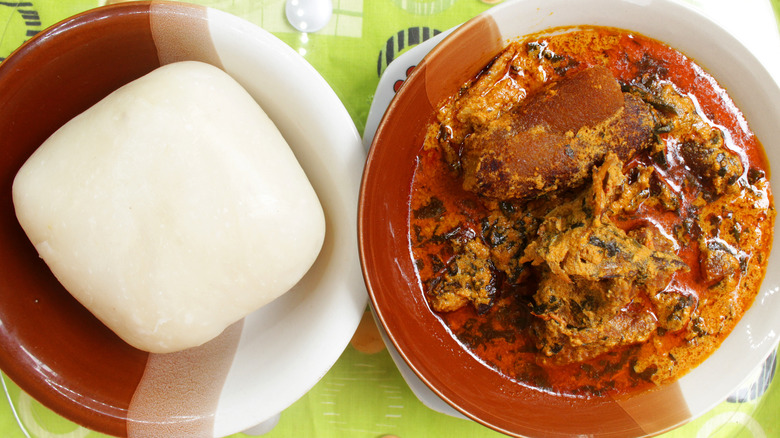The Rules For Eating With Your Hands In India, Africa, And The Middle East
People have been eating with their hands since the beginning of time, and in many regions, it is still the preferred method. However, in places like India, Africa, and the Middle East, there is tradition, culture, and etiquette to be respected and followed.
Spoons, knives, and other cooking tools were used by early humans, but for the better part of human history, eating with your hands was the norm. Eating utensils are relatively new inventions. Evidence of chopsticks was found in China dating back to around 1200 B.C.E, and ancient Egyptian ceremonial spoons from about 1000 B.C.E were discovered. Forks didn't become a thing until around the 1500s in Europe, though according to Scientific American, they existed as early as the 11th century. They were seen as unnecessary and as an extreme luxury reserved for the elite, and it would take another couple hundred years for forks to be adopted by the wider public who up until then, ate with their hands and a knife.
Of course, people around the world eat all sorts of foods with their hands to this day – sandwiches, tacos, pizza, pastries, fried chicken, sushi hand rolls, charcuterie boards, and so on. The foods from India, Africa, and the Middle East are made to make it as easy as possible to eat with your hands, and the consensus is that eating with your hands improves the overall experience of a meal. As former prime minister of India Jawaharlal Nehru once said, "Eating biryani with fork and knife is like making love through an interpreter" (via India Today).
What are the general rules?
First, washing hands thoroughly before eating is key. Use your fingers to create a utensil and the food itself as a tool. Rice, a grain, or flatbread provides the foundation for runnier dishes like a curry or soup. Bunch up a cohesive bite on the plate, and use your fingers to scoop or pinch the food. Do not stick your fingers or palm in your mouth. Instead, use your thumb to push the food in. It takes practice, but your fingers can act as a sort of spoon.
It is also crucial to only use your right hand to touch food or drink, pass dishes, and greet others. To preserve cleanliness, the left hand is historically reserved for activities like going to the bathroom. More specifically, you should eat using only the thumb, index finger, and middle finger, and should only lick your fingers once you are done eating. Strict adherence to this custom varies, but in general, avoiding using the left hand while eating is very important.
The use of the right hand for clean activities and the left hand for unclean activities is explicitly mandated in hadiths, teachings from the Prophet Muhammad. The collection of hadiths focused on daily activities is called the sunnah, direct commandments from the Prophet Muhammad on how to live an honorable life. Muslim influence spread across the Arab world into India, Africa, and Europe beginning around the century of 600 C.E, and has remained culturally ingrained.
What are the specific traditions for eating with your hands in India?
In addition to the importance of Islamic traditions in India, eating with your hands also can be traced back to Ayurvedic teachings. Ayurveda is an ancient medicinal practice based in the Hindu religion that prioritizes "a balance between the body, mind, spirit, and the environment," notes Johns Hopkins Medicine. This whole-body philosophy asserts that the five elements that make up the world also combine to form each individual's constitution or dosha and every finger corresponds to a different element. The thumb represents aakash (space), the forefinger represents vayu (air), the middle finger represents teja (fire), the ring finger represents jala (water), and the pinkie represents prithvi (earth). In Ayurveda, eating with the whole hand stimulates a crucial connection. Practically, eating with the hands promotes mindfulness.
Indian food almost always includes rice and flatbread. Whole wheat, unleavened, tortilla-like breads called chapati, roti, or mani are common across the country. Parathas are flakier and fattier, and yeasted and white flour naan are more decadent, but all are griddled or cooked in a tandoor to get tasty charred spots. Bhatura and puri are puffy and fried. Thin and crepe-like dosas are made with fermented rice and lentil batter. Idlis are also made from a similar batter but are instead formed into cakes and steamed. All these breads act as scooping and dipping vehicles and are a crucial part of eating with your hands in true Indian fashion.
Eating with your hands in the Middle East
An additional layer to Middle Eastern customs around eating with your hands include traditional meals where one large plate is shared amongst a group. Everyone uses their right hand to eat a portion from the area directly in front of them, eating only until they are satiated, not stuffed to the brim. Guests may have particularly delicious pieces of meat moved to their section. This etiquette of only taking your fair share comes from teachings from the Prophet Muhammad.
Rice is common across the Middle East, as is bulgar, freekeh, and couscous. Depending on the country, a typical meal would include grains, grilled or stewed meat or vegetables, salad, and one of the numerous flatbreads eaten across this large and diverse region. In places like Turkey, Egypt, Lebanon, and Iran, expect mezze plates – a variety of many small plates like hummus, cheeses, olives, tabbouleh, and kebabs served with flatbreads such as pita or lavash. In Palestine, falafel may be served alongside ka'ak al Quds, a Jerusalem-style oblong bread ring covered in sesame seeds. In Iraq, and in many variations across the Middle East, the curry and the flatbread can become one dish in lahm bi ajeen or sfiha. A ground lamb or goat mixture is seasoned with warm spices and pomegranate molasses, pressed on top of a flatbread dough, and baked together. It can be served on its own or alongside lentil soup or fattoush salad for a perfect light meal.
Eating with your hands in Northern Africa
Africa is a vast continent of 54 countries with cuisines that have been shaped by numerous ethnic groups, tribes, religious traditions, colonization, immigration, and trade. In general, eating with your hands is common. Depending on the region, Africans use rice, grains, flatbreads, and various types of thick porridge to eat soups, stews, and curries with ease.
Northern Africa has seen a decidedly global influence because of its strategic location. Apart from the customs of the original inhabitants of the land, the Imazighen, also commonly called the Berbers, Northern Africa has been influenced significantly by the ancient Greeks and Romans, as well as the French and Spanish. Moorish traditions remain prevalent across the region, and as such, Muslim customs that are common in the Middle East and India are also common here.
A lot of the cuisine looks similar to other Middle Eastern foods and uses ingredients like dates, almonds, and olive oil. Tajine is an iconic Moroccan dish, named for the decorative clay pot the stew, rice, or couscous is cooked in. While couscous is actually a very small pasta, it is eaten like a grain and is easy to form with your hands to create a well-structured bite. Msemmen, a flaky flatbread common across the region, is similar to an Indian paratha and pairs well with protein or vegetables dressed in garlicky, lemony, herby, chermoula.
Injera – the utensil of choice in the horn of Africa
Injera, also known as budenaa, canjeero, or lahoh, is a spongy flatbread with a tangy sourdough-like taste that comes from fermenting the batter. Traditionally, it is made from teff flour which comes from the milled seeds of a native variety of millet grass, but can also use barley, wheat, corn, or rice flour. The flatbread is most commonly associated with Ethiopia but is also eaten in Eritrea, Somalia, Djibouti, and Sudan.
A large round of injera is spread across a plate, and mounds of curries like doro wat, an oniony chicken stew, lentil dishes, and salads are spooned over the entire flatbread. With your right hand, pinch off pieces of the injera to sample the variety of flavors. More injera is served on the side. Along with followers of Islam and various indigenous belief systems, this area is also home to many Jews and Orthodox Christians, so shellfish and pork are not typically used in the accompanying dishes.
One particularly special custom during communal meals in this region of Africa is the act of gursha, which translates to "mouthful." It is an intimate and loving gesture where one person, the agurash, creates a perfect bite and then feeds another person, the gorash, by hand three times. Gursha is a tender gesture between a young person and an elder, lovers, friends, or as an offer to a special guest.
Commonalities from Western to Eastern Africa
Soups and stews make up much of the traditional foods and are usually served with a mound of starchy mash. West African egusi soup made with stewed beef, vegetables, and ground egusi gourd seeds, spicy central African peanut soup, and East African-Indian kuku paka, or chicken in coconut milk, are all eaten with a starch that makes it easy to scoop up the broth or sauce.
Fufu is the side dish of choice across Western and Central Africa. Ground or grated cassava, also known as yucca, manioc, or arrowroot, is a popular base for fufu. It can be boiled or pounded into a cassava flour dough using a large mortar and pestle. Yams, plantains, rice, and semolina flour can also be used to make fufu. Tear off a small piece of fufu, flatten and create an indentation, and use the fufu to scoop up the stew. Most traditionally, fufu is not supposed to be chewed, but if you're a fufu newbie, go ahead and chew it!
Slightly different versions of cornmeal-based starchy sides are eaten in the same way as fufu across East and South Africa. In Tanzania and Kenya this dish is called ugali, nshima in Malawi and Zambia, posho in Uganda, sadza in Zimbabwe, and pap or mieliepap in South Africa and Botswana. Use your hands to form a perfect piece and dunk away. No utensils needed!

